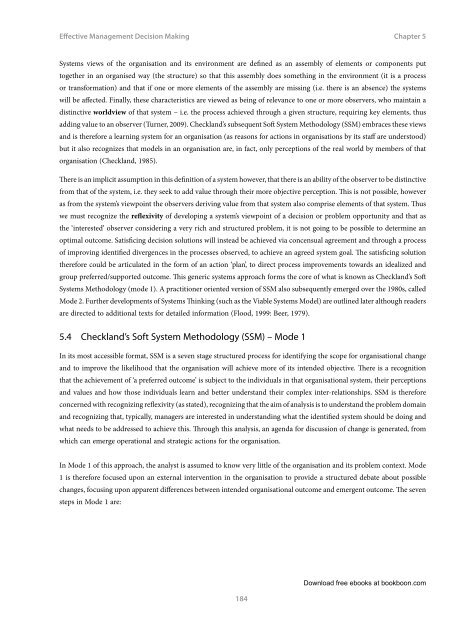Effective Management Decision Making Language ... - Tutorsindia
Effective Management Decision Making Language ... - Tutorsindia
Effective Management Decision Making Language ... - Tutorsindia
Create successful ePaper yourself
Turn your PDF publications into a flip-book with our unique Google optimized e-Paper software.
<strong>Effective</strong> <strong>Management</strong> <strong>Decision</strong> <strong>Making</strong>Chapter 5Systems views of the organisation and its environment are defined as an assembly of elements or components puttogether in an organised way (the structure) so that this assembly does something in the environment (it is a processor transformation) and that if one or more elements of the assembly are missing (i.e. there is an absence) the systemswill be affected. Finally, these characteristics are viewed as being of relevance to one or more observers, who maintain adistinctive worldview of that system – i.e. the process achieved through a given structure, requiring key elements, thusadding value to an observer (Turner, 2009). Checkland’s subsequent Soft System Methodology (SSM) embraces these viewsand is therefore a learning system for an organisation (as reasons for actions in organisations by its staff are understood)but it also recognizes that models in an organisation are, in fact, only perceptions of the real world by members of thatorganisation (Checkland, 1985).There is an implicit assumption in this definition of a system however, that there is an ability of the observer to be distinctivefrom that of the system, i.e. they seek to add value through their more objective perception. This is not possible, howeveras from the system’s viewpoint the observers deriving value from that system also comprise elements of that system. Thuswe must recognize the reflexivity of developing a system’s viewpoint of a decision or problem opportunity and that asthe ‘interested’ observer considering a very rich and structured problem, it is not going to be possible to determine anoptimal outcome. Satisficing decision solutions will instead be achieved via concensual agreement and through a processof improving identified divergences in the processes observed, to achieve an agreed system goal. The satisficing solutiontherefore could be articulated in the form of an action ‘plan’, to direct process improvements towards an idealized andgroup preferred/supported outcome. This generic systems approach forms the core of what is known as Checkland’s SoftSystems Methodology (mode 1). A practitioner oriented version of SSM also subsequently emerged over the 1980s, calledMode 2. Further developments of Systems Thinking (such as the Viable Systems Model) are outlined later although readersare directed to additional texts for detailed information (Flood, 1999: Beer, 1979).5.4 Checkland’s Soft System Methodology (SSM) – Mode 1In its most accessible format, SSM is a seven stage structured process for identifying the scope for organisational changeand to improve the likelihood that the organisation will achieve more of its intended objective. There is a recognitionthat the achievement of ‘a preferred outcome’ is subject to the individuals in that organisational system, their perceptionsand values and how those individuals learn and better understand their complex inter-relationships. SSM is thereforeconcerned with recognizing reflexivity (as stated), recognizing that the aim of analysis is to understand the problem domainand recognizing that, typically, managers are interested in understanding what the identified system should be doing andwhat needs to be addressed to achieve this. Through this analysis, an agenda for discussion of change is generated, fromwhich can emerge operational and strategic actions for the organisation.In Mode 1 of this approach, the analyst is assumed to know very little of the organisation and its problem context. Mode1 is therefore focused upon an external intervention in the organisation to provide a structured debate about possiblechanges, focusing upon apparent differences between intended organisational outcome and emergent outcome. The sevensteps in Mode 1 are:184Download free ebooks at bookboon.com
















